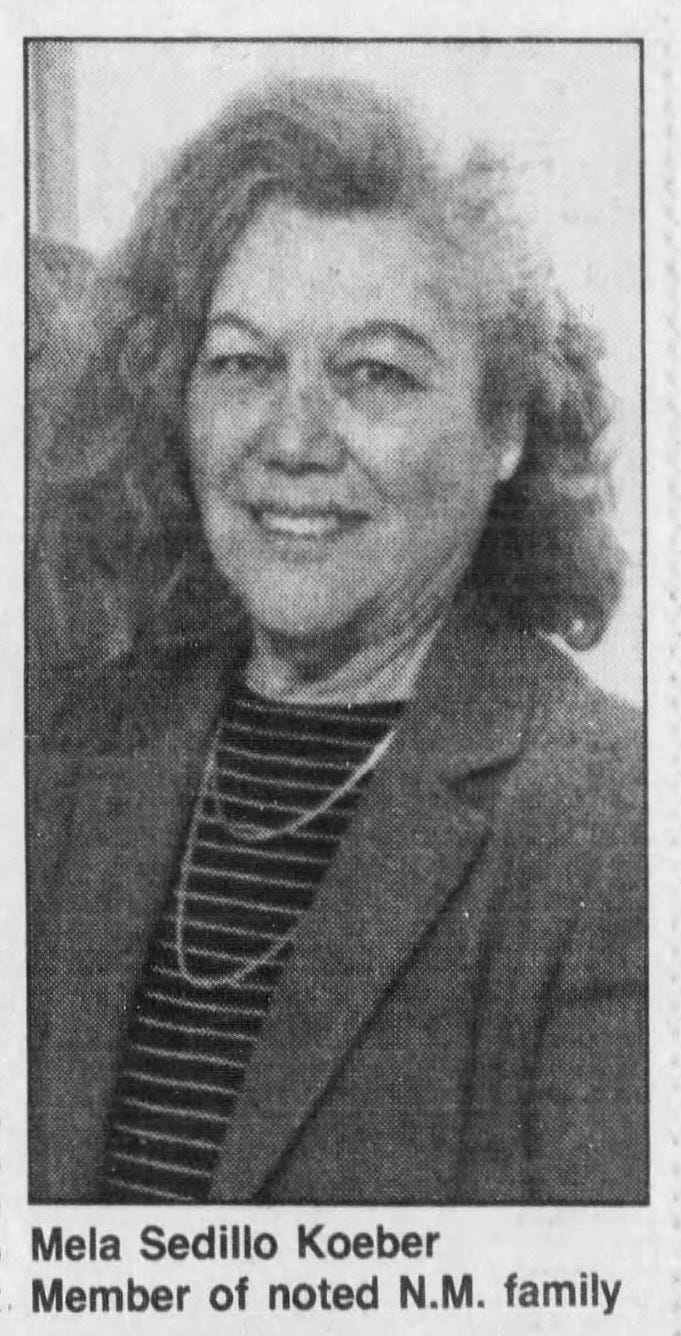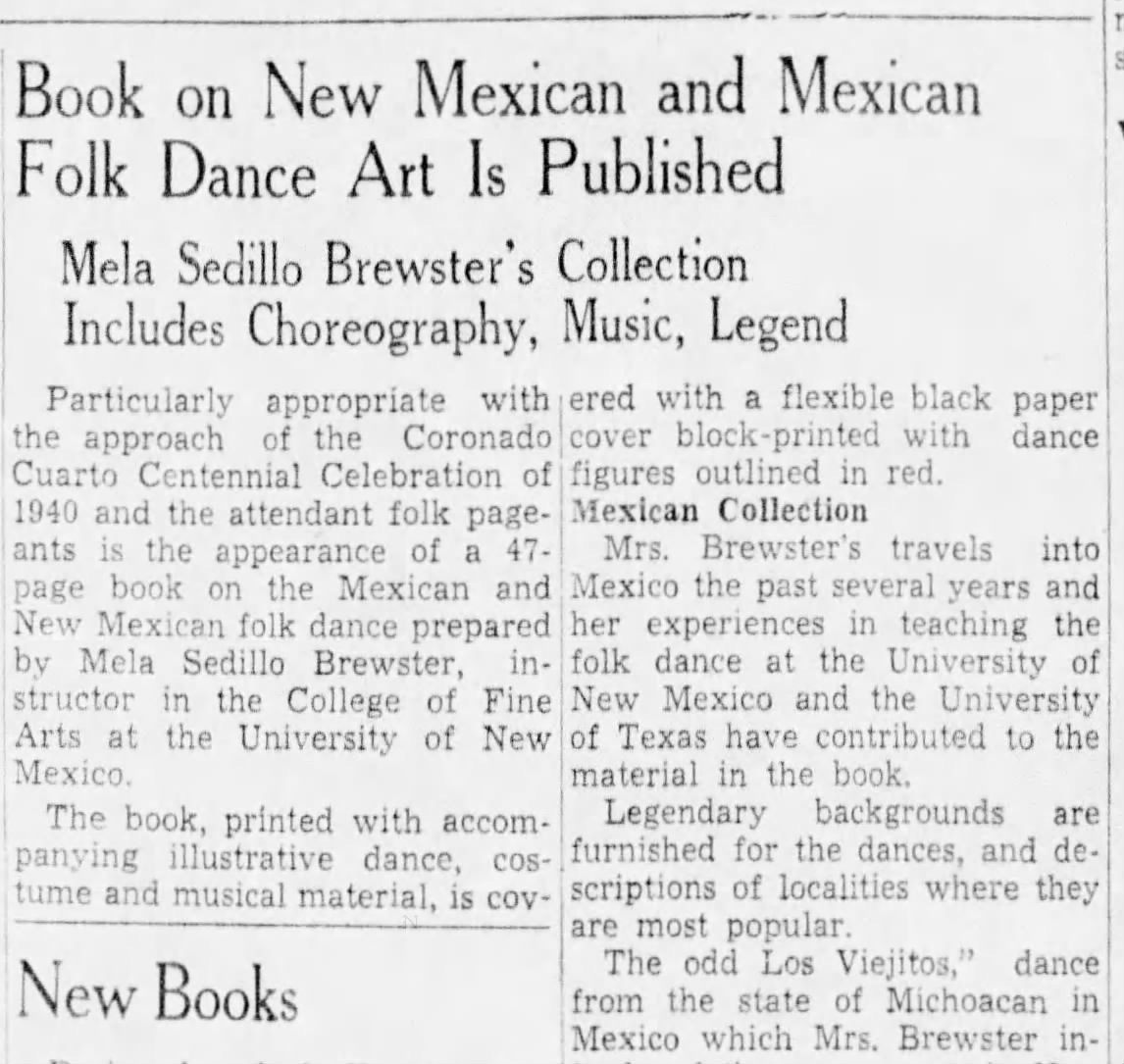The Life of Mela Sedillo Brewster Koeber
Cultural Preservation and Institutional Change in 20th-Century New Mexico
After uncovering the remarkable story of Doña Lola Chavez de Armijo, I found myself returning to the acknowledgments in Erna Fergusson's "Mexican Cookbook" for other names with stories waiting to be told. Among them was Mela Sedillo Brewster Koeber, unfamiliar to me, but I was curious to know if it promised another hidden legacy.
It's easy to overlook contributors in cookbook margins, assuming their roles were minor. But as I learned with Doña Lola, these women were often the true keepers of tradition, whose knowledge and creativity helped shape the culture others would later claim and celebrate.
My research through university archives, newspaper articles, and festival programs revealed a life at the crossroads of tradition and transformation. Mela wasn't just an educator and folklorist, but a force for cultural preservation and community leadership. Her journey from Albuquerque's historic neighborhoods to the halls of Columbia University to becoming UNM's first dance teacher illuminates the challenges and triumphs of Hispana women in twentieth-century Southwest. At the same time, her experiences present a revealing look into broader patterns of exclusion, cultural preservation, and institutional change in New Mexico.
Mela Sedillo Brewster Koeber was born in Albuquerque in 1903, into a family that was deeply rooted in New Mexico's past and actively shaping its future. Her father, Antonio Abad Sedillo, was a lawyer and legislator, and her brothers, Juan and Filo, would go on to serve in the state's legislature and judiciary. The Sedillo family's presence in public life wasn't just a matter of status. It reflects a long tradition of civic engagement and leadership within New Mexico's Hispano community.
Given the Sedillo family's prominence in public life and deep roots in the state and community, it's reasonable to assume that Mela would have been surrounded by discussions of civic responsibility and cultural identity from an early age. The family's political involvement and commitment to public service suggest an environment where questions of leadership, community engagement, and New Mexico's evolving identity would have been central concerns.
Mela's later dedication to preserving and teaching traditional dances, folk arts, and Spanish language demonstrates she had significant exposure to these cultural traditions during her formative years. Her ability to serve as a cultural bridge-builder and her deep knowledge of New Mexican heritage point to an upbringing that valued education and cultural preservation. This foundation in civic responsibility and cultural pride would be evident as she navigated the complexities of identity, tradition, and change in twentieth-century New Mexico.
Mela recognized that heritage wasn't something to be taken for granted. It was to be nurtured, celebrated, and when necessary, defended. These values shaped her path from her family home in Albuquerque to the classrooms and cultural institutions where she would leave her mark.
Mela's pursuit of higher education represented both family legacy and bold new territory for Hispana women. Graduating from UNM in 1926, she was one of the small number of Spanish-surnamed students navigating an Anglo-centric campus. Her early experiences highlight persistent barriers. Despite becoming a charter member of Chi Omega sorority, she faced exclusion and "unwritten rules" limiting Hispanic participation. Rather than accept tokenism, she resigned. It was a quiet act of protest reflecting growing ethnic consciousness among New Mexican Hispanos.
This exclusion reflected wider institutional marginalization that ultimately led to the early 1930s Anti-Fraternity Bill, when Hispanic lawmakers contested discriminatory Greek practices. These barriers did not hinder her, Mela used them as motivation. She earned a Rockefeller Fellowship for graduate studies at Columbia University, where she deepened her expertise in art, folklore, and education.
After returning to New Mexico in the early 1930s, Mela joined UNM's Art Department in 1932, becoming the university's first dance teacher. Her courses in Spanish and Mexican folk arts, design, and language were part cultural preservation and affirmation. She created classrooms where students saw their histories reflected. Mela was especially devoted to folk dances, believing that movement and music were essential tools for preserving cultural memory.
Beyond the university, she participated in New Deal cultural initiatives. This included the Federal Writers' Project and WPA programs, organizing festivals, and documenting traditions while bringing recognition to local artists during economic hardship. Her bilingual public lectures and community workshops connected generations and bridged cultural divides, demonstrating how marginalized communities use cultural work as both resistance and resilience.
As a prolific writer and researcher, Mela documented traditions that shaped New Mexican identity. Her most influential work, “Mexican and New Mexican Folkdances” (1935, revised 1945), combined detailed descriptions, musical notation, and historical context. She co-authored “The San Jose Project” (1933), a pioneering rural education study, researched natural vegetable dyes, and offered ethnographic sketches in “Mexican Scenes” (1934). Her Spanish-language poetry, including "Comunion" and "Hija Bruja," express deep connections to language and landscape. Additionally, her contributions to Fergusson's “Mexican Cookbook” extended her cultural preservation work to culinary traditions.
With husband Robert Koeber, Mela became steward of the historic Refugio Gomez House in Old Town, transforming it into a cultural hub for artists, writers, and community leaders. The adobe home hosted folk dance rehearsals, poetry readings, and discussions about culture and politics. Mela helped nurture new spaces for cultural memory beyond institutional boundaries.
Her public service was equally significant. She served on the New Mexico Parks and Recreation Commission and the early Albuquerque Open Spaces Advisory Committee, advocating for preservation and environmental stewardship. In 1968, she was a delegate to the Democratic National Convention. Throughout her life, she mentored young artists, supported festivals, championed historic preservation, and helped establish a more inclusive understanding of New Mexican identity.
When Mela died in 1989, her legacy lived on in the communities she served, the students she inspired, and the traditions she sustained. Her papers at UNM's Center for Southwest Research continue to inform scholars and cultural workers.
Mela Sedillo Brewster Koeber's life shows us how institutional exclusion and cultural preservation intertwine. Her response to barriers at UNM, turning exclusion into cultural leadership, helped lay the groundwork for later advances in representation. Her story shows how individuals affect institutional change not only by confronting barriers directly, but also by building parallel structures that can reshape institutions from within.
Her legacy remains relevant as we continue wrestling with representation, equity, and cultural identity. Students and professionals from marginalized backgrounds still encounter barriers, while pressures of globalization threaten local identities. Mela's example of using cultural work as resistance and community building is an example of adaptation through persistent, creative engagement.
By bringing back stories like hers, we're not just correcting the record but inspiring new generations to continue the work of inclusion, preservation, and change. Her story, once tucked away in the margins, is an inspiration for anyone working to make their communities more inclusive and true to their roots.
Gonzales, Phillip B. "Spanish Heritage and Ethnic Protest in New Mexico: The Anti-Fraternity Bill of 1933." New Mexico Historical Review 61, no. 4 (October 1986): 283–312.
“Mela Sedillo, 1925, 1934, 2006." NM Archives Online, University of New Mexico Center for Southwest Research & Special Collections.
Sedillo, Mela C. “Mexican and New Mexican Folkdances.” Albuquerque: University of New Mexico Press, 1945.











